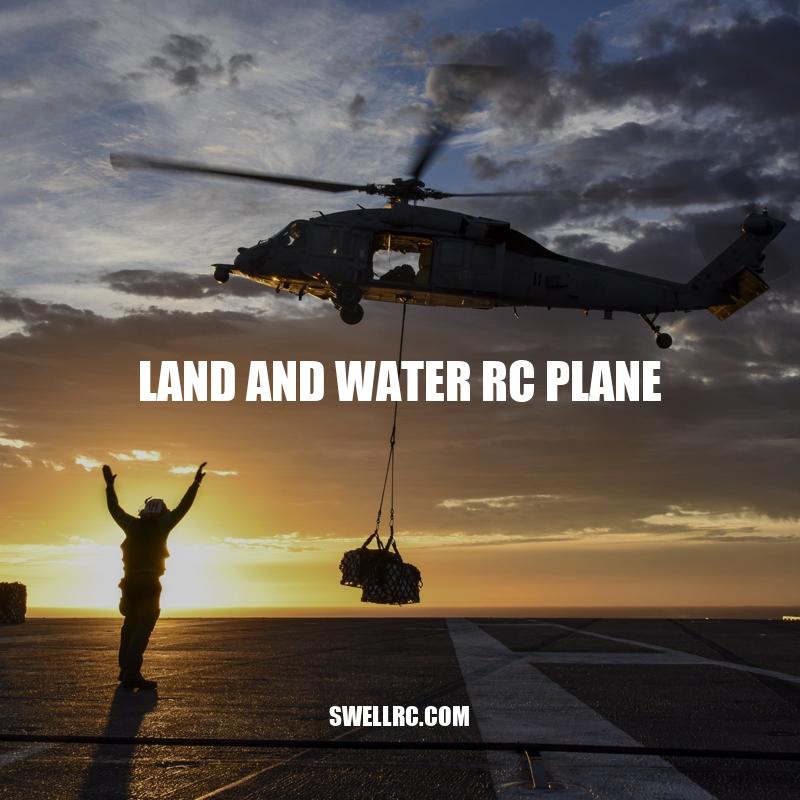Land and Water RC Plane: The Ultimate Versatile Flying Machine
Have you ever wanted an RC plane that can soar through the skies, skim across water, and take off and land on land effortlessly? Look no further than the land and water RC plane, a versatile and durable aircraft that allows pilots to experience the thrill of flight on two elements. With this innovative invention, you can explore new horizons and perfect your flying skills on different surfaces. The land and water RC plane is engineered to conquer all terrains, and the excitement it offers is unparalleled. Whether flying over a serene lake or a green field, this RC plane provides hours of joy and discovery. In this article, we’ll dive into what makes this aircraft so unique and how to best utilize it for maximum enjoyment.
Features and Specifications
The land and water RC plane has several unique features that make it stand out from other RC planes, including:
- The ability to operate on land, water, and snow
- A durable, waterproof design that protects the plane’s internal components
- Powerful brushless motors that provide high speeds and strong acceleration
- Responsive controls that enable smooth and precise flying
- Lightweight construction that allows the plane to perform stunts and maneuvers with ease
- A range of up to 300 meters, giving you plenty of space to soar
In addition to these features, the land and water RC plane also comes in different sizes and colors, providing options for pilots of all levels. Some popular options include the HobbyZone Sport Cub S2, the HobbyZone AeroScout S, and the Mini Talon. These planes can be purchased online through websites such as Amazon, HobbyKing, or Horizon Hobby. If you’re looking for a more affordable option, there are also several DIY kits that allow you to build your own land and water RC plane from scratch.
What do you know about RC airplanes specifically?
RC airplanes, also known as RC planes or radio-controlled aircraft, are miniature flying machines that have their flights controlled by an operator on the ground through a hand-held radio transmitter. These aircraft come in different sizes, from small, indoor foam planes to large gasoline-powered models for outdoor use. RC airplanes are mostly built for hobbyist use and competitions, with different types including gliders, sport planes, scale models, and drones. For more information on RC planes and accessories, websites like Horizon Hobby and Tower Hobbies offer a wide range of products and resources.
Tips for Flying on Water
Flying a land and water RC plane on water can be tricky, but with a few simple tips, you’ll be able to enjoy a smooth and safe flight.
- Choose calm waters: Flying on choppy waters can make it difficult to control the plane. Choose a calm lake or pond for best results.
- Trim the plane: Adjust the trim of the plane to make sure it’s evenly balanced and level on the water. This will help prevent the plane from flipping over.
- Use the rudder: The rudder controls the direction of the plane, so use it to steer the plane on the water. A small adjustment can make a big difference.
- Keep the speed steady: Avoid sudden changes in speed, as this can cause the plane to lose stability. Maintain a steady speed for a smooth flight.
One interesting fact about land and water RC planes is that they can be used for aerial photography and filming. With a camera mounted on the plane, you can capture stunning views of lakes, rivers, and other bodies of water.
If you’re interested in purchasing a land and water RC plane, there are several options available on popular websites such as Amazon, HobbyKing, and Horizon Hobby. Here is a table comparing some popular models:
| Model | Price | Size | Flight Time |
|---|---|---|---|
| HobbyZone Sport Cub S2 | $169.99 | 47.0 in wingspan | 10-15 minutes |
| HobbyZone AeroScout S | $149.99 | 54.6 in wingspan | 8-10 minutes |
| Mini Talon | $114.99 | 40.6 in wingspan | 15-30 minutes |
Can you land a water plane on land?
Yes, some seaplanes can land on land as they are equipped with wheels. However, most seaplanes are designed to land only on bodies of water since they are equipped with floats.
Tips for Flying on Land
Flying a land and water RC plane on land is a unique experience that requires some different techniques than flying on water. Here are some tips for a successful flight:
- Choose a flat, open area: Find a clear area free of obstacles, like trees or buildings, where you can take off and land safely.
- Use the wheels: Make sure the landing gear is securely attached to the plane and roll the plane for takeoff.
- Adjust the trim: The trim controls the flight path of the plane, so adjust it for best performance on the ground.
- Check the wind: Be aware of wind speed and direction, as gusts can affect the stability of the plane.
One thing to note is that land and water RC planes are not designed for acrobatics or extreme maneuvers. They are best used for leisurely flights and aerial photography.
For those interested in purchasing a land and water RC plane, there are a variety of different models available on websites such as Amazon and eBay. Some of the most popular models include:
| Model | Price | Size | Flight Time |
|---|---|---|---|
| Amphibious Remote Control Airplane | $54.99 | 16.9 in wingspan | 8-10 minutes |
| Land and Water Remote Control Plane | $49.99 | 15.0 in wingspan | 7-9 minutes |
| Wing Surfer RC Airplane | $119.99 | 38.6 in wingspan | 10-20 minutes |
How do you land an RC plane on water?
Landing an RC plane on water can be a challenging task. You need to make sure that your plane is designed for water landing and that you have enough skill to control it properly. To land your RC plane on water, start by reducing its speed and altitude. Then, approach the water at a shallow angle and gently touch down on the surface, maintaining enough speed to keep the plane moving. You can also consider using floats or water rudders to help with water landing. Check out this video tutorial for more tips and techniques: https://www.youtube.com/watch?v=zdUbTCdmXQk.
Maintenance
Proper maintenance is essential in extending the lifespan of your land and water RC plane . Here are some general maintenance tips you can follow:
- Clean your plane: Keep your plane clean by using a damp cloth to gently wipe it down after every flight.
- Store your plane properly: Always keep your plane in a cool, dry place, and avoid exposing it to extreme temperatures.
- Check for damage: Before every flight, inspect your plane for any cracks, dents, or other damage that might affect its performance.
- Replace old batteries: If the batteries in your plane start to lose their charge, replace them with fresh ones.
If your land and water RC plane has water components, like pontoons and underwater propellers, there are additional maintenance steps you should take to ensure their longevity:
- Rinse with fresh water: After flying on saltwater or dirty water, make sure to rinse the plane’s water components with fresh water to remove any dirt or residue that might have accumulated.
- Dry components thoroughly: Allow the water components to dry thoroughly before storing the plane away.
- Inspect for damage: Check the water components for any cracks or damage, and replace them as needed.
If you’re unsure about how to care for your specific land and water RC plane model, consult the manufacturer’s instructions or visit their website for more information.
For those in need of replacement parts or accessories for their planes, there are several online retailers that offer a variety of options. Some popular choices include HobbyKing, Banggood, and Horizon Hobby.
How do you land a water plane?
To land a water plane, it is recommended to land in the smoothest water possible and directly into the wind while using the maximum flaps recommended by the aircraft’s manufacturer. Both floats should touch the water at the same time and the attitude should be slightly above normal pitch attitude on touchdown. It is important to avoid conducting a full stall landing. For more information, refer to aviation websites or products that provide guidance on water plane landing techniques.
Accessories
There are many accessories available for land and water RC planes that can enhance your flying experience and provide extra fun for the whole family. Here are some popular options to consider:
- Float Sets: Float sets are available for RC planes not already equipped with water components, allowing them to operate on water.
- Landing Gear: Landing gear is available for planes that do not have it included, allowing for smoother landings on various terrains and reducing the risk of damage to the plane.
- FPV Systems: First-person-view (FPV) systems allow you to see what your RC plane sees while flying, providing a more immersive experience. Some systems come with advanced features such as GPS tracking.
- Upgraded Batteries: Upgrading the batteries can result in longer flight times and increased power for more impressive aerial maneuvers.
- Repair Kits: Repair kits include all the necessary tools and replacement parts to fix your plane in case of damage.
When purchasing accessories for your land and water RC plane, be sure to consult the manufacturer’s specifications to ensure compatibility with your specific model. Several websites offer a range of accessories including Amazon, eBay, and dedicated RC plane retailers like Flite Test and Motion RC. With the right accessories, you can take your land and water RC plane to the next level and have even more fun flying it.
How do you pick servos for RC planes?
When picking servos for RC planes, there are several factors to consider. The weight and size of the model should determine the torque your servo should provide. The control surface area and servo arm length are also crucial factors to consider. In addition, the speed of the servo can significantly affect the “feel” of your model. A fast servo is great, but it should not be too fast; otherwise, it can cause your RC plane to feel twitchy. Some helpful websites to consider when selecting servos for RC planes are Horizon Hobby and Tower Hobbies.
Conclusion
In conclusion, the land and water RC plane is a versatile and enjoyable piece of technology that can provide hours of fun for both beginners and experienced aviation hobbyists. With its unique design and maneuverability, the land and water RC plane presents an exciting opportunity to explore new terrains and approaches to flying. Whether you prefer to take off from land or water, this RC plane provides flexibility and practicality that cannot be matched by other models.
When selecting a land and water RC plane, be sure to consider your skill level, budget, and specific needs, such as range and durability. Remember to always follow safety guidelines, both for your own protection and the longevity of the plane. With regular maintenance and care, your land and water RC plane will provide you with many memorable flights.
In summary, the land and water RC plane is a versatile and fun technology that can be enjoyed by the whole family. Whether you’re looking to fly on land, water, or both, this type of RC plane provides a thrilling experience that will keep you engaged for years to come.



